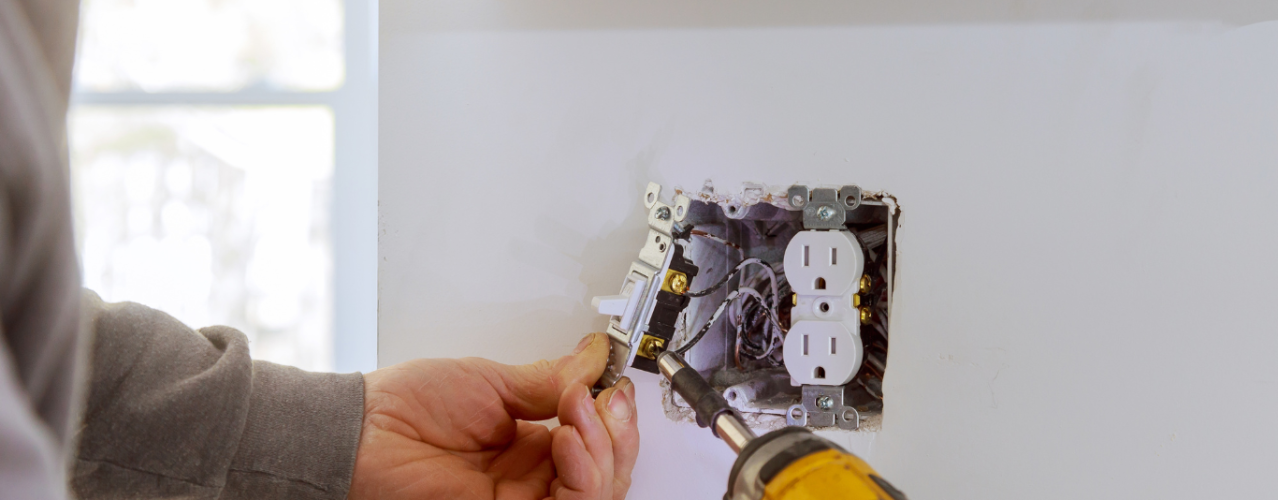

News I published 02 December 2022
Share of installers working remotely differs vastly between countries
Labour shortages are an ever-pressing issue in the world of construction and installation. That is also the case for electrical installers, who are in high demand and ever shorter supply in most European markets. One solution is to improve installers’ efficiency so they can do more installations in less time, for instance by developing plug-and-play systems that are quick and easy to install.
That might save time on the installation but does not reduce time spent on maintenance and solving problems and malfunctions in systems that are already installed. Luckily, an increasing number of products and systems are connected to the internet. Aside from allowing owners control at a distance, these connected smart products allow installers the opportunity to monitor performance, assess malfunctions and run diagnostics of systems at a distance.
This possibility can save installers enormous amounts of travel time, as they may be able to solve a problem at a distance. If not, it allows installers to come well prepared and faster and more efficient on-site visits. Manufacturers are increasingly developing connected installation products that also allow working at a distance and can potentially save installers much time, but how many installers are making use of this possibility?
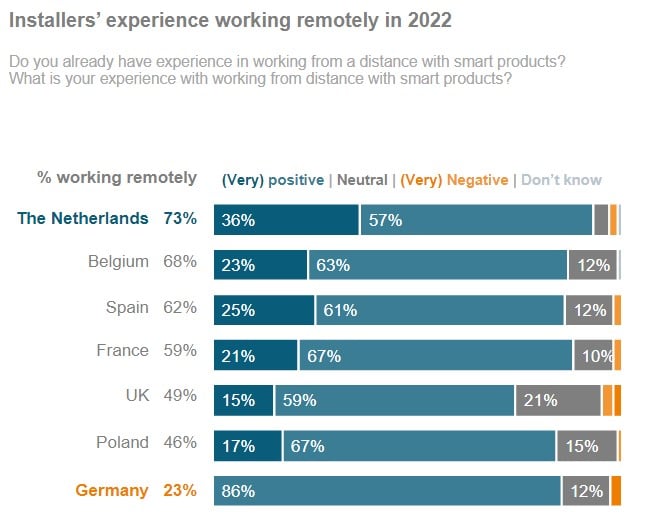
Installers work remotely the most in the Netherlands and the least in Germany
For the Q2 2022 report of USP Marketing Consultancy’s European Electrical Installation Monitor, which focuses on smart buildings, we asked electrical installers from seven major European markets whether they have experience with working at a distance with smart installation products. As it turns out, this varies widely per country. The largest share of installers that have experience working remotely is found in the Netherlands (73% of installers), which is not surprising. As we saw in a previous article, the Netherlands also has the highest share of installers involved in installing smart products.
The country with the lowest share of installers working remotely is Germany, where only 23% of installers claim to have such experience. This may have little to do with the number of smart products installed, and more with legislation. The most concrete explanation is that Germany has some of the strictest privacy legislations in Europe. That complicates the legal aspects of accessing a client’s system, thus preventing installers from working remotely.
Working remotely expected to continue to grow
Aside from legislation preventing installers to work remotely, they may also just be reluctant to change their way of working. Like many construction and installation professionals, electrical installers can be traditional in this, which can delay the growth of working remotely a little. Nevertheless, the time saving benefits of working remotely will win it from tradition if work pressure is high, which is what we already see in some countries.
Interestingly, installers who have experienced working remotely are positive about it. In all countries, most installers who worked remotely liked it, and only a tiny fraction considered the experience negative. By now this should not come as a surprise, but as a confirmation that working remotely indeed gets more jobs done faster in times of high work pressure due to labour shortages.
These shortages are expected to be a continuing problem. Meanwhile, the number of smart products installed is growing and the demand for smart systems will only increase due to other trends like sustainability for instance. Put together, both incentive and opportunity for installers to work remotely with smart products will only increase in time to come.
For manufacturers of smart installation products, it is essential to know in which markets these products are used the most and how usage is developing. For an overview of installers’ usage of and experience with smart building products and installations in seven European countries, we refer you to the Q2 2022 report of USP Marketing Consultancy’s European Electrical Installation Monitor.

Read more about the subject


18 July 2024 I Dirk Hoogenboom
Willingness to invest of European consumers in sustainability improvements of their houses lower in 2024 than in 2023
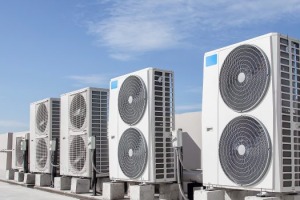

02 July 2024 I Dirk Hoogenboom
BIM adoption among European HVAC installers remains low
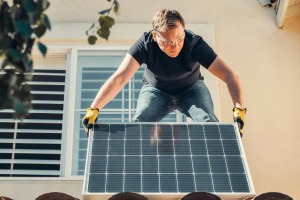

06 June 2024 I Maja Markovic
Sustainability in the electrical installation sector; slow but steady growth


06 June 2024 I Dirk Hoogenboom
Trends in construction material usage

Fresh Insights Await
Our latest reports
Delve into the newest findings across various market segments, crafted for a cutting-edge overview. Explore our latest reports, brimming with up-to-date data, trend analyses, and in-depth examinations, all tailored to provide you with a comprehensive understanding of the current market dynamics.
Construction
Home Improvement
Installation
Construction
Trends in material usage Q1 2024
2024 102 pages
Explore the evolving trends in material usage among European architects in Q1 2024. Delve into the factors driving material preferences and the impact on construction aesthetics and sustainability.
1,850 Euro
Construction
Media orientation H2 2021
2024 161 pages
Explore the media engagement patterns of contractors to optimize your marketing strategies. Dive into a pool of insights that unveils how contractors interact with different media channels.
6,300 Euro
Construction
European Green Deal Q4 2021
2024 88 pages
Explore the impact and reception of the European Green Deal among architects. Understand how the initiative is influencing architectural practices and sustainability measures.
1,850 Euro
Construction
BIM Q4 2023
2024 246 pages
Key insights regarding the BIM usage and behaviour of European architects, and our latest future building volumes prognoses
1,850 Euro
Construction
Purchase Channels H2 2023
2024 123
Explore the buying and ordering behaviour among contractors in H1 2023. Uncover the key channels used, share-of-wallet and much more.
6,300 Euro
Construction
Behavioural segmentation and media usage report 2023
2023 75 pages
This report provides a comprehensive overview of purchase behaviour, products, and media usage, specifically focusing on European handymen. It delves into how handymen use media, and for what purposes, and examines their habits and preferences in terms of purchasing behaviour.
8,400 Euro
Home Improvement
DIY versus DIFM Q4 2021
2024 113 pages
This report is a must-have if you’re in the home improvement industry. It provides a wealth of information on the behaviour of DIY and DIFM consumers, their motivations, and the factors that influence their purchasing decisions.
3,150 Euro
Home Improvement
DIY or DIFM Q4 2023
2024 70
Explore the prevailing trends between DIY and DIFM in Q4 2023. Understand consumer preferences and the factors influencing their choice between DIY and DIFM.
3,150 Euro
Home Improvement
Branding Q3 2023
2023 93 pages
This report offers an extensive overview of the home improvement industry, with a focus on branding and the most popular brands within different categories. Within this report, you will gain insights into how customers perceive home improvement brands and what motivates them to buy certain products.
3,150 Euro
Home Improvement
Purchase channels Q2 2023
2023 114 pages
The European Home Improvement Monitor offers valuable insights on purchase channels in the European home improvement industry, examining the evolving preferences and behaviors of consumers across traditional retail and emerging online platforms.
3,150 Euros
Home Improvement
Purchase Channels Q2 2022
2022 124 pages
Uncover the prevalent purchase channels in the home improvement sector during Q2 2022. Delve into consumer preferences and the factors influencing their purchasing decisions.
3,150 Euro
Home Improvement
Do-it-yourself or do-it-for-me Q4 2022
2022 93 pages
Explore the prevailing trends between DIY and DIFM in Q4 2022. Understand consumer preferences and the factors influencing their choice between DIY and DIFM.
3,150 Euro
Installation
Smart & Connected Products Q2 2024
2024 120 pages
This report provides a comprehensive view of the attitudes of installers toward smart building solutions, specifically among electrical installers and their clients. In the report, you will find insights into the installers' experiences with installing smart products and the willingness of end users to invest in such solutions, as well as their motivations and pain points.
3,150 Euro
Installation
Sustainability Q1 2024
2024 81 pages
Delve into sustainability trends in the home improvement sector in Q1 2024. Discover consumer preferences and the shift towards eco-friendly home improvement solutions.
3,150 Euro
Installation
BIM Q1 2024
2024 84 pages
The European Mechanical Installation Monitor report provides a detailed analysis of the plumbing and HVAC industry. This report specifically focuses on BIM adaptation in the industry.
2,650 Euro
Installation
Sustainability Q1 2024
2024 99 pages
The European Electrical Installation Monitor report provides a detailed analysis of the sustainable solutions in the installation industry. This report specifically focuses on sustainability aspects in the industry.
3,150 Euro
Installation
Challenges toward sustainable future Q4 2021
2024 111 pages
2,650 Euro
Installation
Purchase channels Q4 2021
2024 106 pages
Delve into the training needs within the electrical installation sector. Understand the areas requiring skill development to meet the evolving demands of the industry.
3,150 Euro








